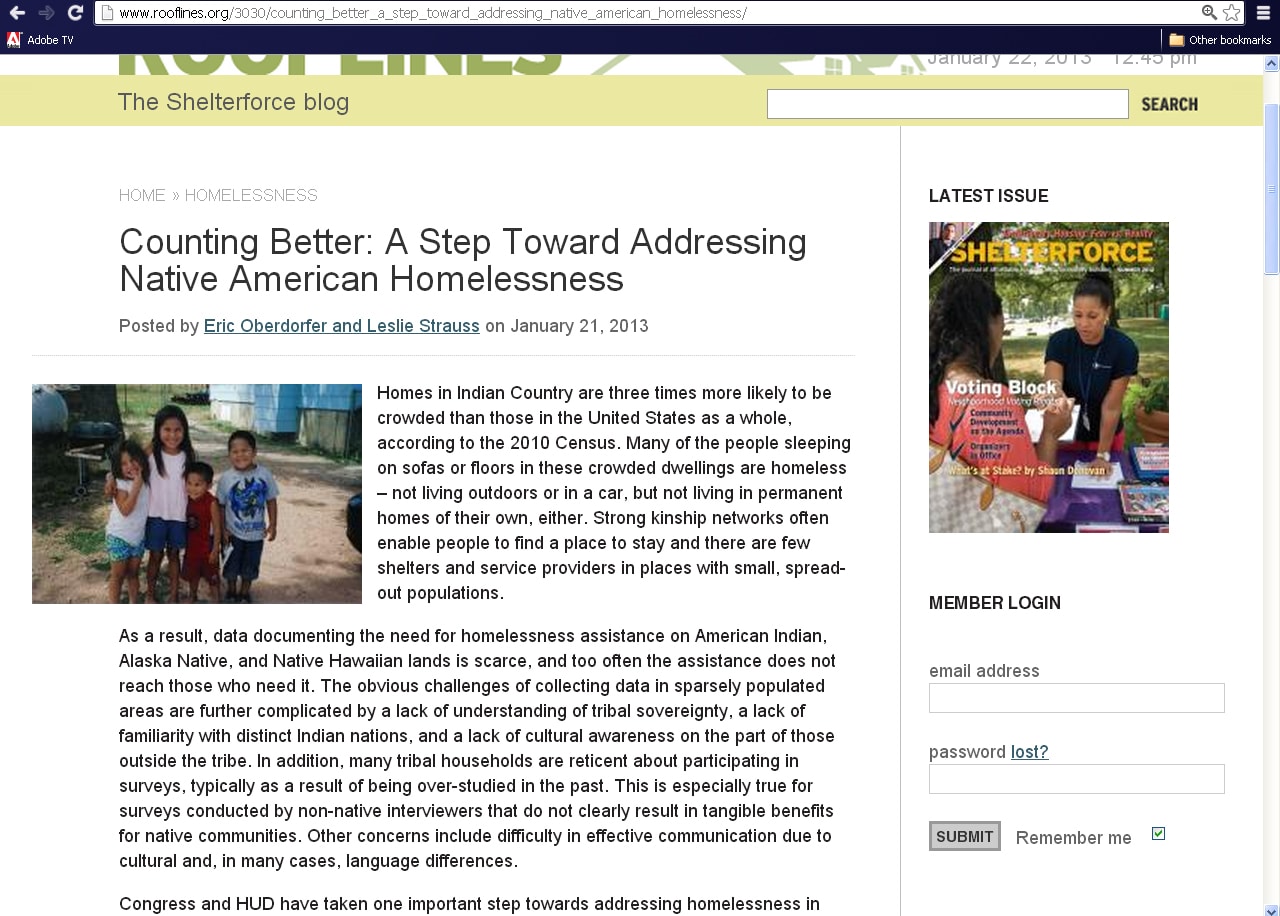HAC News: January 23, 2013
HAC News Formats. pdf
January 23, 2013
Vol. 42, No. 2
• OMB tells agencies to plan for sequester, CBPP reports smaller cuts • Administration’s FY14 budget will be late • Congressional leadership changes still in process • Secretaries Vilsack and Donovan to remain in new Administration • NOFAs issued for Housing Counseling, ICDBG, Healthy Homes, YouthBuild, SHOP • Some rural mortgages exempt from new escrow rule • New poverty guidelines released • HUD compiles environmental training webinars • Many Blacks and Latinos would be impacted by sequestration • Smart Growth America supports reexamination of priorities • HAC blog post tackles Native American homelessness
January 23, 2013
Vol. 42, No. 2
OMB tells agencies to plan for sequester, CBPP reports smaller cuts. A memo from the Office of Management and Budget advises federal agencies to intensify planning for possible sequestration, but not to take action yet. Unless Congress changes the law, federal funding will be cut on March 1. The Center on Budget and Policy Priorities calculates that because of changes made in the tax deal (see HAC News, 1/10/13) the cut for non-defense discretionary programs including housing will be 5.1% rather than the previously expected 8.2%.
Administration’s FY14 budget will be late. OMB informed House Budget Committee Chair Paul Ryan on January 11 that delays in congressional action on the “fiscal cliff” delayed the Administration’s FY14 budget preparations and the budget will be submitted after the February 4 due date. OMB does not give a specific release date.
Congressional leadership changes still in process. In the 113th Congress, Sen. Barbara Mikulski (D-MD) is the new chair of Senate Appropriations. For House Appropriations, Rep. Ed Pastor (D-AZ) is the new ranking member (top Democrat) on the Transportation-HUD Subcommittee. Rep. Sam Farr (D-CA) continues as ranking member on the Agriculture Appropriations Subcommittee. The new chair of the Senate Agriculture Appropriations Subcommittee has not yet been announced, nor have the top Senate Republicans on both Appropriations and Banking. All committees also have some new members, as in any new Congress.
Secretaries Vilsack and Donovan to remain in new Administration. Tom Vilsack will continue to serve as Secretary of Agriculture and Shaun Donovan as Secretary of Housing and Urban Development.
NOFAs issued for Housing Counseling, ICDBG, Healthy Homes, YouthBuild, SHOP. Housing Counseling applications are due March 18; contact HUD staff, housing.counseling@hud.gov. Indian Community Development Block Grant applications are due March 18; contact Roberta Youmans, HUD, 202-402-3316. Academics, nonprofits, for-profits, state and local governments, and tribes can apply for Healthy Homes Technical Studies funds by March 19; contact Dr. Peter Ashley, HUD, 202-402-7595. YouthBuild applications from nonprofits, state and local governments, and tribes are due to the Employment and Training Administration by March 19; contact Kia Mason, ETA, 202-693-2606. Intermediaries can apply by April 24 for Self-Help Homeownership Opportunity Program funds to be loaned to others; contact Ginger Macomber, HUD, 202-402-4605.
Some rural mortgages exempt from new escrow rule. Effective June 1, the Consumer Financial Protection Bureau will require private mortgage lenders to maintain escrow accounts for “higher-priced” loans for five years rather than one year. Small portfolio lenders that serve primarily rural or underserved areas and do not escrow for other mortgages are exempt. “Rural” is defined on a county basis: “a county is rural if it is neither in a metropolitan statistical area nor in a micropolitan statistical area that is adjacent to a metropolitan statistical area.” CFBP will publish a list of these counties. Contact David Friend, CFPB, 202-435–7700.
New poverty guidelines released. The Department of Health and Human Services has adjusted its poverty guidelines to account for a 2.1% increase in the cost of living from 2011 to 2012. For programs that use this benchmark, the 2013 poverty line for a family of four in the continental U.S. is $23,550.
HUD compiles environmental training webinars. Online sessions from 2011 and 2012 covering a variety of topics related to environmental reviews are at www.onecpd.info/learning-center/environmental-review-training/.
Many Blacks and Latinos would be impacted by sequestration. A study by the Center for Social Inclusion found higher numbers (not percentages) of Blacks and Latinos than Whites will be impacted if sequestration goes into effect. Based on program funding cuts of 8.2% (not the 5.1% currently estimated by CBPP; see first item in this HAC News) to non-defense discretionary programs, about 115,000 Black and Latino individuals would lose HUD tenant-based vouchers, 90,000 would lose homelessness assistance, and almost 850,000 would lose LIHEAP home energy aid. Falling Off the Fiscal Cliff? Race, Opportunity and Sequestration also includes data for a few individual states.
Smart Growth America supports reexamination of priorities. Federal Involvement in Real Estate: A Call for Examination reports that in 2008 federal housing spending (direct and through taxes) averaged $6,253 for households with incomes of $200,000 and above, $254 for those with incomes in the $30,000-40,000 range, and $833 for those with incomes under id=”mce_marker”0,000. It also notes that 84% of federal real estate funding supports home-ownership while 35% of households are renters. SGA suggests that federal policy be targeted to support balanced housing choices; reinvest in existing places and properties; provide a safety net; and help more Americans reach the middle class.
HAC blog post tackles Native American homelessness. Based on a forthcoming guide from HAC and the Corporation for Supportive Housing, “Counting Better: A Step Toward Addressing Native American Homelessness” recommends local counts of homeless people on Native lands to document the need for assistance.

